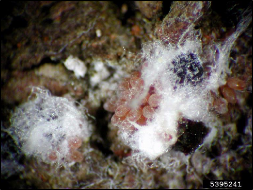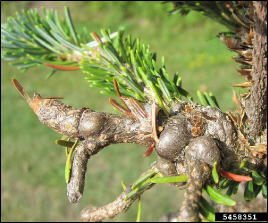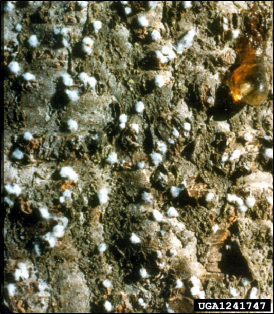Balsam Woolly Adelgid
ID
3006-1452 (ENTO-434NP)
Introduction
Balsam woolly adelgid, Adelges (Dreyfusia) piceae (Ratzeburg), belongs to the family Adelgidae in the order Hemiptera. Native to central Europe, the balsam woolly adelgid is now distributed throughout eastern and western North America. It attacks all true firs (Abies spp.), including balsam and Fraser fir.
Description
The balsam woolly adelgid life cycle includes the egg, three nymphal instars, and the adult stages. Adult females (there are no males) are wingless, oval, purplish-black insects measuring about 0.8 mm in length. The females secrete waxy threads around their bodies that form a dense, woolly sack where they may deposit a cluster of >200 eggs (Fig. 1).

The first instar "crawlers" are reddish-brown and about 4 mm long. The crawlers are the only stage capable of moving and dispersing among host trees. Once a crawler finds a suitable feeding location, it inserts its tube-like mouthparts into the bark of the host and remains there for the rest of its life. The second and third instars measure about 0.5 to 0.65 mm in length, respectively, and closely resemble the adult female.
Life History
Balsam woolly adelgids pass the winter as dormant first-instar nymphs. Development is completed in the spring, with adult numbers peaking in late May or early June. A second generation peaks in mid- August and produces the overwintering generation.
Damage
Introduced from Europe around 1900, the balsam woolly adelgid is considered a serious pest of forest, seed production, landscape, and Christmas trees. Populations are generally found either on the outer portions of Abies spp. tree crowns or on the main stem and large branches. Stem infestations are usually more serious, causing greater levels of damage and mortality. Abnormal drooping of the current shoots and gouting of the outer twigs (Fig. 2) characterize crown infestations. The crown becomes increasingly thin and dieback may occur. Persistent crown infestation over a number of years can kill a tree.

Stem attacks are characterized by the conspicuous presence of white woolly masses that can give the lower bole a whitewashed appearance when heavily infested (Fig. 3). Injury by adelgid feeding produces an “allergic” reaction in the wood that causes swelling of the sapwood, gouting of the twigs, and increased heartwood formation in the sapwood. This abnormal growth of sapwood, called "rotholz” or “redwood", inhibits water flow within the tree.

Cultural Control
If only a few trees are infested on a Christmas tree plantation, removing or burning those trees should be sufficient to manage balsam woolly adelgid. If removing infested trees from the property, carefully wrap those trees in a tarp before moving to limit the accidental spread of the pest to any remaining trees. If the infestation is more wide spread, chemical treatment may be necessary.
In forest situations, silvicultural and management techniques can be used to reduce adelgid populations and damage. Tree stress may be minimized by thinning overstocked stands; by fertilizing sites of poor nutrient quality (although some nitrogenous fertilizers such as urea can increase the numbers of this pest); and by replanting or encouraging more tolerant tree species and varieties. A damage-hazard rating system based on site and stand characteristics associated with severe adelgid damage can be used to aid in management decisions (Page 1975). The main variables used in the system are site elevation, soil moisture regime, percent balsam fir by basal area, total basal area of balsam fir, and stand age. In general, dry sites at lower elevations with more than 40% balsam fir and trees more than 45 years old are most susceptible to balsam woolly adelgid. True firs between 25 and 45 years old are moderately susceptible, and trees less than 25 years old are least susceptible.
Chemical Control
Chemical control can be used effectively on ornamental, seed production, and Christmas trees. Treat with a registered insecticide following recommendations found in the current Horticulture and Forest Crops Pest Management Guide (VCE Publication 456-017) for commercial plantings, or in the Home Grounds and Animals Pest Management Guide (VCE Publication 456-018) for home owners. As with all pesticides, follow the label instructions carefully with regards to rates and precautions.
References
Page, G. 1975. The impact of balsam woolly aphid damage on balsam fir stands in Newfoundland. Can. J. For. Res. 5:195-209.
Revised
Theresa A. Dellinger, February 3, 2021.
Virginia Cooperative Extension materials are available for public use, reprint, or citation without further permission, provided the use includes credit to the author and to Virginia Cooperative Extension, Virginia Tech, and Virginia State University.
Virginia Cooperative Extension is a partnership of Virginia Tech, Virginia State University, the U.S. Department of Agriculture (USDA), and local governments, and is an equal opportunity employer. For the full non-discrimination statement, please visit ext.vt.edu/accessibility.
Publication Date
March 1, 2021



